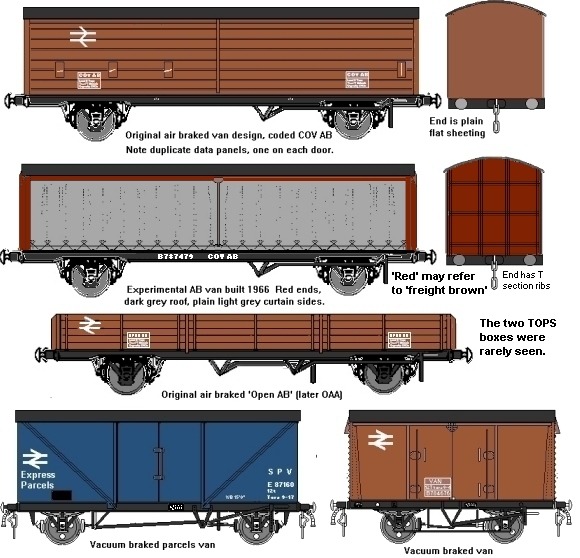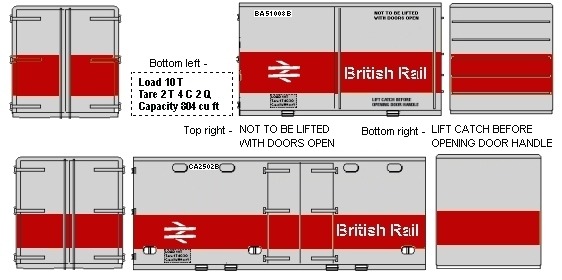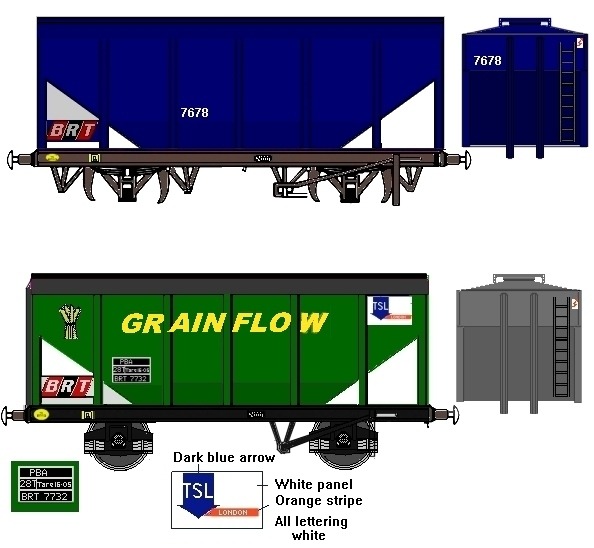
| Return to index page |
British Rail (Pre TOPS - 1964-1975)
NB The colours used were obtained by sampling colour pictures, they may however vary from the true colour, use as a rough guide only
In 1964/65 came the new Corporate Image, with the standard livery to be
applied to all stock irrespective of region. British Railways became British
Rail to emphasise the new 'lean and efficient' organisation. This change saw
the introduction of the `rail blue' colour for diesel and electric loco's and
the blue and grey livery for non-passenger coaching stock (parcels vans, GUV's
etc.). The old BR regional colours were abandoned, the original BR enameled signs were replaced by rectangular flat metal enameled signs with white backgrounds and black sans-serif lettering, the lettering used was the same font but the old BR 'long arrow with flights' was truncated to a short black arrow. Unlike the old signs the new signs had turned back edges at top and bottom only, the ends being open. These signs were soon common where paying passengers might be found but were less common in goods yards where the old signs remained in place, often right up until closure. The Brute platform trolleys were painted rail blue but post office trolleys were still GPO red.
The new livery also featured the much maligned double arrow logo, even British Railways was a little confused at first as to which way these should point, although this was finally resolved with the upper one pointing to the right. There had been a similar problem with the early British Railways logo, British Railways preferred the lion to face forwards on both sides of the locomotives, however this conflicted with the rules of the College of Heralds, with whom the `device' was registered. The College wanted the lion facing to the right irrespective of its placement on the locomotive and I am not sure if this was ever satisfactorily resolved before the change to the Corporate livery.
Freight stock colours were changed to 'freight grey' for
unfitted stock and 'freight brown' for fitted stock (and occasionally unfitted
stock). Freight grey was slightly darker than the original grey and freight
brown was slightly darker and browner version of bauxite. As I use home-mixed
rather than precision colours this change is reflected in a slightly darker
weathering coat of dirty thinners. The unfitted vehicles, other than the steel
mineral types, were by this time getting rare. The Graham Farish range includes
the early air-braked van and open wagon in this livery, complete with the
British Rail double-arrow logo.
As with the initial change to British
Railways the application of the new liveries was a slow business, there were
still quite a few mineral wagons in the rusty remains of their original British
Railways livery up to the mid 1980's. Passenger train stock, including parcels
types, tended to be painted more frequently and by the time of the 1964
Corporate Image there were very few crimson or crimson & cream vehicles
still running. The corporate livery was also applied to Post Office travelling
Post Office stock, which had been pillar box red before this time.
Wagon and van markings were in white, with a white rectangular box round them, the lines of which were about 1 inch (25mm) wide. Initially the wagon codes were the national standard telegraphic codes, introduced during the war, PLATE for plate wagons, COV AB for the first of the new air braked vans etc. On the HOP 32 AB merry-go-round hopper, which had an aluminium painted body, the markings were in the standard form but used white on the chassis and black on the aluminium.
Initially British Railways planned to use numbers prefixed B as before for their own air braked stock but in the event only the 32 ton MGR coal hoppers were so numbered and all subsequent air braked stock had plain numbers with no prefix. Air braked stock was numbered in the range 100000 to 990049.
One change was the introduction, in the early 1970's, of a yellow plate mounted behind the label clip which replaced the earlier 'Return To . . .' branding and the BR yellow circuit working disk. The yellow circuit disk was still sometimes used, painted on the body side above the yellow plate (I have only seen this on mineral and hopper wagons). The labels used in the clips were not white, they were brown (similar the dreaded brown envelopes bills used to come in), pre printed with black markings and were filled in with pencil.
Fig ___ Post 1964 British Railways liveries for goods stock

The older style containers used in the Speedfreight system remained in use however some of the metal bodied versions appeared in a livery similar to that adopted by the early Freightliners containers, plain metal with a red band bearing white stenciled markings and additional markings on the lower sides in black. Not all Speedfreight containers received this livery, many saw out their life in the original grey and yellow scheme.
Fig ___ Post 1964 British Railways liveries for Speedfreight
containers 
During this period that the Peco type grain wagons (introduced in 1965) mainly operated in plain blue livery but some were rebuilt with spring type suspension and hired out to the Grainflow service.
Fig ___ Liveries for Peco Grano wagon 